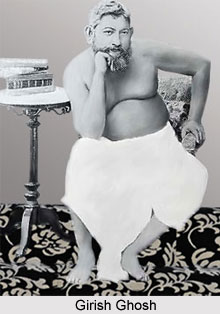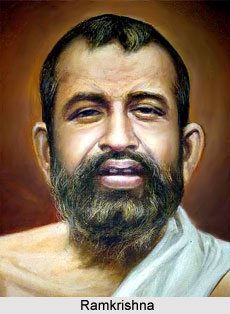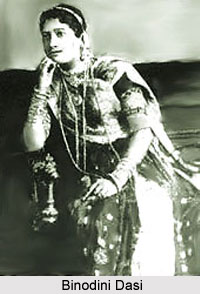 Religion and spiritually, in general, influenced Bengali theatre to a large extent. Many theatre writers, led by of course, Girish Ghosh strived hard to make sure that people realized the religious and spiritual richness that Hinduism had. So, Girish Chandra Ghosh did find a way of writing for the theatre that would incorporate both native as well as foreign traditions into a final product, unique even in its own hybridity. Hybridity, processed through Ghosh`s genius, thus earned validity as an emergent form of its own. Bilwamangal Thakur, as a result, is a bhakti play in the tradition of Baishnab drama and Jatra. At the same time it is also a conflict and denouement-driven Western style play, divided into five acts. The play, however, ends with a sort of an epilogue that is situated outside the scenic/episodic structure of the text.
Religion and spiritually, in general, influenced Bengali theatre to a large extent. Many theatre writers, led by of course, Girish Ghosh strived hard to make sure that people realized the religious and spiritual richness that Hinduism had. So, Girish Chandra Ghosh did find a way of writing for the theatre that would incorporate both native as well as foreign traditions into a final product, unique even in its own hybridity. Hybridity, processed through Ghosh`s genius, thus earned validity as an emergent form of its own. Bilwamangal Thakur, as a result, is a bhakti play in the tradition of Baishnab drama and Jatra. At the same time it is also a conflict and denouement-driven Western style play, divided into five acts. The play, however, ends with a sort of an epilogue that is situated outside the scenic/episodic structure of the text.
Coming of Ramakrishna in Bengali Theatre
Turning the public theatre holy was a project that Girish Ghosh, the erstwhile atheist, had undertaken under the influence of Shri Ramakrishna (1836-86), the saint-teacher, who became the spiritual guru of many leading theatre practitioners in the last decades of the nineteenth century. Ghosh`s encounter with Sanyasaa of Ramakrishna does not span a long period but the connection between the two had a big impact on the former.
 Among the first babus to be attracted to the gospel of Ramakrishna and the man himself was Keshab Chandra Sen (1838-84), the leading preacher of the Brahmo Samaj started by Raja Ram Mohan Roy that propagated an abstract monotheistic interpretation of Hinduism. But ideas and Religious Teachings Of Ramakrishna were far from abstract. His conception of divinity and worship of the Almighty was deeply entrenched in idolatry and concrete performative devotional practices that, however, were non-sectarian, syncretic and integrative. Keshab Chandra Sen`s attraction to and his role in popularizing Ramakrishna among the Bengali intelligentsia signalled, among other things, the ultimate failure of the Brahmo Samaj movement to create a popular appeal among the larger Bengali Hindu community of the late nineteenth century and unite it.
Among the first babus to be attracted to the gospel of Ramakrishna and the man himself was Keshab Chandra Sen (1838-84), the leading preacher of the Brahmo Samaj started by Raja Ram Mohan Roy that propagated an abstract monotheistic interpretation of Hinduism. But ideas and Religious Teachings Of Ramakrishna were far from abstract. His conception of divinity and worship of the Almighty was deeply entrenched in idolatry and concrete performative devotional practices that, however, were non-sectarian, syncretic and integrative. Keshab Chandra Sen`s attraction to and his role in popularizing Ramakrishna among the Bengali intelligentsia signalled, among other things, the ultimate failure of the Brahmo Samaj movement to create a popular appeal among the larger Bengali Hindu community of the late nineteenth century and unite it.
Meeting of Ramkrishna and Girish Ghosh
Girish Chandra Ghosh had met Ramakrishna first time soon after, the former had recovered from a serious disease in 1880s. This "miraculous" recovery eventually became reason for him to give up atheism and find solace in divine faith. Ghosh had seen Ramakrishna twice at babu houses in Kolkata, where the holy man had been invited to preach. None of these experiences had had a major impact on him; he continued to remain indifferent to Ramakrishna, although his curiosity had been whetted. Then, in 1884, Ghosh launched his production of Chaitanyaleela on the life and times of the medieval Vaishnab Bhakti cult leader Nimai Chaitanya (1486-1534) at the Star Theatre, Kolkata and nothing more than exchanges of social niceties in the foyer of the theatre occurred between the two men on that night. But at the end of the performance, Ramakrishna did go backstage and meet the actors, particularly Binodini Dasi who had played (in cross-gendered casting) the role of Chaitanya.
 Ghosh met Ramakrishna a third time at yet another babu residence where both had discussion about various philosophies of life. Thereafter, Ghosh met Ramakrishna Paramahansa at regular intervals and, once, even insulted the master in a drunken stupor when Ramakrishna refused to agree to be born again as his son! But his belief and dependence on Ramakrishna grew quickly and with remarkable intensity. So much so that Ghosh contemplated giving up the theatre and devoting himself entirely to serving his guru, to which Ramakrishna objected. Ghosh lamented no more and devoted himself to the karma of his life - theatre.
Ghosh met Ramakrishna a third time at yet another babu residence where both had discussion about various philosophies of life. Thereafter, Ghosh met Ramakrishna Paramahansa at regular intervals and, once, even insulted the master in a drunken stupor when Ramakrishna refused to agree to be born again as his son! But his belief and dependence on Ramakrishna grew quickly and with remarkable intensity. So much so that Ghosh contemplated giving up the theatre and devoting himself entirely to serving his guru, to which Ramakrishna objected. Ghosh lamented no more and devoted himself to the karma of his life - theatre.
Influence of Ramkrishna in Bengali Theatre
Ramakrishna died in 1886, but that did not destroy Ghosh. On the contrary, it strengthened him to stay on course. In fact, it was in the post-Ramakrishna phase of his career that Ghosh wrote some of his best plays and directed some of his best productions. In turn it was Bengali theatre that enhanced. Until he met Ramakrishna, Ghosh was a greatly disturbed man whose life had been beset with innumerable tragedies. He had led the reckless life of a social rebel, living in the forgetful oblivion of hedonistic pleasure seeking. But all of his atheism, hedonism and rebellion could not explain the social situation around him; he had no control over it. The appearance of Ramakrishna in his life gave him a tool that would help him make sense of the world he inhabited.
Ramakrishna`s influence on Bengali theatre has been tremendous, with far-reaching consequences. His intimate contact with theatre people and their admiration for him sanctified the theatre and helped dissipate much of the anti-theatrical prejudice of the Bengali bhadralok community. Ramakrishna, who was to be canonized posthumously as a modern day avatar of Lord Vishnu, had `rescued` the fallen theatre practitioners and turned the profane space of representation into an extension of the place of worship. With his touch, the Bengali public theatre had become a miraculous, spectacular site for imaging/imagining divinities of many sorts.
The change in the social status of the Bengali public theatre that set in during the last two decades of the nineteenth century was supported by a parallel aesthetic development. With the help of Ramakrishna, Ghosh helped establish a new creed for hybridity in the Western-style Bengali theatre. Ramakrishna`s earthy, folk wisdom informed Ghosh and his alert sensibility that was already engaged in negotiating a creative space between cultures. It augmented Girish Chandra Ghosh`s sensibility with a philosophical base that helped recreate a form of performance that had generally modelled itself on a Western paradigm - the proscenium stage, the audience in the dark behind the invisible fourth wall, concert hall-style auditorium, action-driven drama, realism and all its attendant characteristics.




